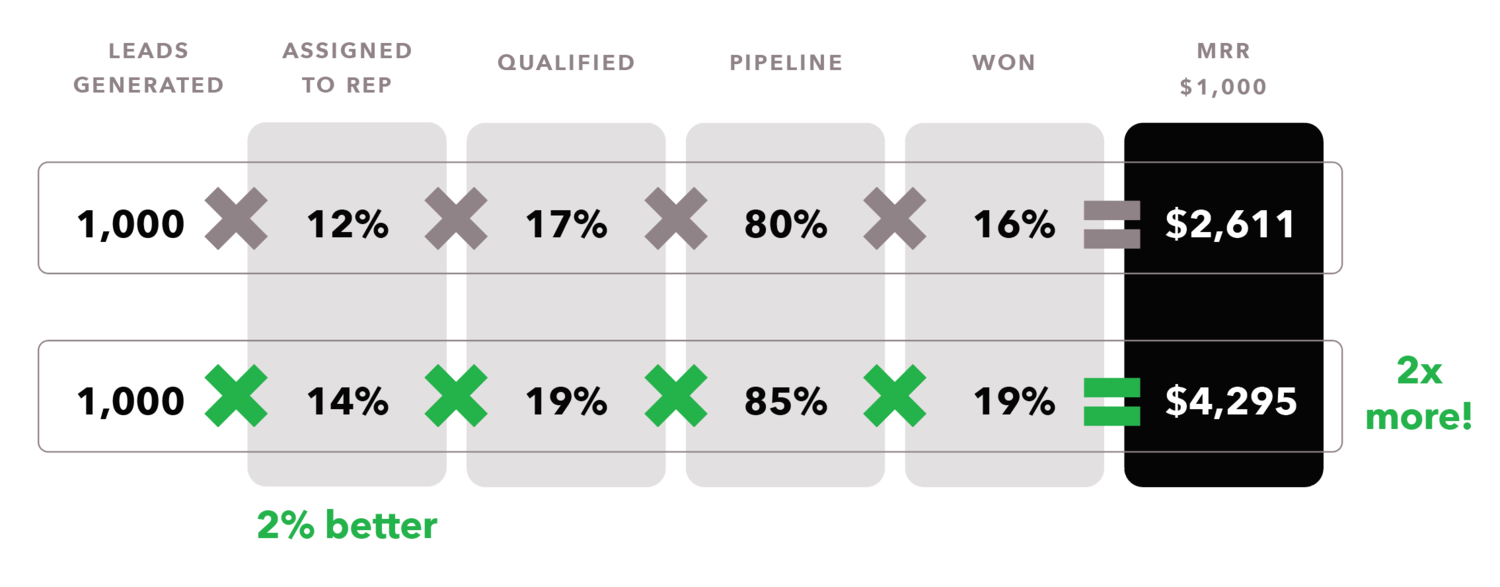Build marginal gains with daily, focused discipline.
There’s a trade-off between growth models; either invest as much as you can to grow as fast as you can, or focus on efficiency to grow in a sustainable, profitable way.
Moving to an efficiency-based model is usually driven by something predictable; a new competitor who enters your space or your financial markets drying up for funding. Not easy challenges, but somewhat expected ones.
These are unpredictable times. A global pandemic has changed how you go to market, who you sell to, and many of your previous growth channels are offline. This impacts if you survive and how you will grow when the pandemic is over.
Regardless, there is likely to be a shift in what VCs care about, that is, efficiency over growth at all costs.
Moving to a capital efficient growth model is a good idea in good times and in bad. In good times, you will be rewarded with higher valuations. If bad times hit, you’ll already be a veteran at operating efficiently and relentlessly monitoring your deal https://www.varicent.com/whitepapers-studies/The-Deal-Health-Systemhealth.
Operating lean and efficiently from the top down allows you to not only weather the down times but also grow even faster during the boon times.
You can envision an efficiency growth model but it’s another thing to operationalize it and hold yourself and your team accountable.
In this post, I’ll outline the following key elements of an efficient growth model:
- Build marginal gains with daily, focused discipline
- Work every lead to its full potential
- Don’t let deals die on the vine
- Drive product-lead growth
- Manage your team with visibility and accountability
Build marginal gains with daily, focused discipline
Instead of looking for one silver bullet, it’s important to look at all of the incremental improvements you can make at every stage of the funnel.
The growth-at-all-costs model isn’t sustainable anymore. The days of adding more demand gen programs, and more reps in an attempt to generate leads is counterintuitive to efficiency and more often than not results in a bloated, capital-heavy business model and a leaky funnel. In times of economic hardship, layoffs are inevitable because the model wasn’t efficient to begin with.
Now, more than ever, we are all expected to do more with less while still meeting our revenue numbers and making shareholders happy. But with the current crisis:
- You have less money to spend on marketing programs
- You have fewer marketing channels to spend in because you can't do programs like in person events anymore
- You may have fewer humans in both marketing and sales to do the work
- You may need to pivot to an entirely new market or ICP depending on how far reaching the impact of COVID-19
Slow and steady wins the race, so focus on the many small changes that you can do to see consistent marginal gains. The first step is to identify where there are leaks in your funnel. Here are some pointed questions to ask your team and start the conversation:
- Are you getting the right leads in the door, or anyone who visits your website counts?
- Are you working every lead quickly and fully, and monitoring how they are dispositioned, or are leads dying on the vine?
- Are you optimizing the hand-offs between Marketing and SDRs, SDRs and AEs, AEs and CSMs?
- Are you working every opportunity fully or letting deals die on the vine due to poor pipeline inspection habits?
- Are you looking for silver bullets or taking a compound “interest” approach?
If you make a 2% change at each stage of your funnel, it compounds. It doesn't just lead to like a 2% improvement in revenue, it has a significant impact.

Image taken from The Deal Health System
These funnels have the same input – 1000 leads – but dramatically different revenue numbers. The difference between the two is sales execution. It’s small – only a 2% to 5% change in conversion at each stage of the funnel – but it nearly doubles the revenue potential for the team!
- Focus on the daily choices by reps: Reps create an out-sized impact on your business yet many sales organizations don’t manage or coach to this. When you miss your targets it’s easy to blame outside forces. But you’re not in control of most of those variables. You are in control of the systems and processes within your sales organization. Your reps are the inputs into your system. Help them take the next right action, every day.
- Streamline operational processes: Focus on what your team controls in the systems and processes within your sales organization and how your team is executing them daily. For example, you control how many people you engage within an account. How can operations make that metric visible, marketing help identify missing contacts, and sales engage with them?
Incremental improvement is your silver bullet when it comes to scale.
It’s the 1% improvement over time that gets you the gold.
How to work every lead to its full potential
If an MQL falls in a forest, and no one is there to work it, does it contribute to revenue?
Every day your team makes a choice: when, why, and how to work a lead or account. Every lead is precious in the course of “regular” business operation and especially now when we are seeing purchasing freezes and more unknowns than ever before.
The measurable lead model is, functionally, how your team already works with prospects.
You have four questions to ask about the efficiency of your lead model:
- Did you work every lead?
- Did you work them quickly, meaning a fast response time?
- Did you work them fully, meaning you completed your sequence steps?
- How are they being dispositioned –are they unqualified, not in a buying cycle (nurture), or qualified?
From here you can understand the profitability of those leads (CAC) and quality of those leads (conversion to won).
Our new sales rep grader can help you increase visibility of your key sales metrics and hold sales teams accountable in a distributed work set up.

Move to a product-led growth strategy
The SaaS companies who are succeeding in this very challenging market are taking bold and immediate steps to redefine and execute on efficient growth models and lean go-to-market processes. Product-led growth is one of the most efficient ways to build your business.
Product led growth is a core part of any B2B strategy regardless of your industry.
A few key takeaways to help your team adapt:
- Play war games with your data in times of peace
- Know the difference between your customer and your user
- Try out how new features convert first, don’t build the entire feature
- Adoption networks are key to understanding your personas
- Growth via SEM can often just masks issues in your process
There is undoubtedly going to be a shift in what VCs care about as we weather the after effects of this global crisis. Now, more than ever - but really as much as ever - we need to champion capital efficiency models over growth at all costs.
In good times, you will be rewarded with higher valuations. If bad times hit, you’ll already be a veteran at lean and efficient sales operations and be able to ride out the storm with the confidence that you are doing everything you can.



